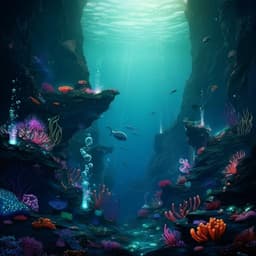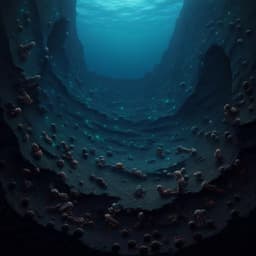
Earth Sciences
Arctic deep-water anoxia and its potential role for ocean carbon sink during glacial periods
K. Jang, K. S. Woo, et al.
Explore groundbreaking findings by Kwangchul Jang, Kyung Sik Woo, Jin-Kyoung Kim, and Seung-Il Nam that reveal how deep-water freshening beneath pan-Arctic ice shelves during glacial periods may have turned the western Arctic Ocean into a hidden carbon reservoir. This research sheds light on the influences of paleo-ice sheets on Polar Deep Water conditions over the last 76,000 years.
~3 min • Beginner • English
Introduction
Glacial periods featured markedly lower atmospheric CO2, with much of the drawdown stored in the deep ocean. While the Southern Ocean has been implicated as a major glacial CO2 sink via enhanced stratification and oxygen depletion, the Arctic Ocean’s role remains debated. Conflicting geochemical evidence has left glacial Arctic salinity and oxygenation uncertain, with foraminiferal records often discontinuous during intervals of freshening and anoxia. This study targets alternative archives and proxies—authigenic inorganic carbonates from core PS72/410-1 on the Mendeleev Ridge—to reconstruct Polar Deep Water (PDW) conditions over the last 76 kyr, testing the hypothesis that the western Arctic PDW became brackish and anoxic during cold stadials, with implications for glacial carbon storage.
Literature Review
Prior work indicates deep oceans as dominant CO2 reservoirs during glacials and highlights Southern Ocean stratification and dysoxia. In the Arctic, suggestions include dysoxic bottom waters inferred from Mn absence, but a prevailing view of oxygenated conditions persisted for the late Quaternary. Recent 230Thex minima in Arctic/Nordic sediments led to proposals of freshwater-filled basins during MIS 6 and 4, though this is contested by continuous foraminiferal δ18O records in the Nordic Seas/Fram Strait. Deep Arctic waters today are saline and oxygenated via brine-driven ventilation, yet the glacial hydrology (salinity, oxygenation) remains controversial given conflicting geochemical proxies and gaps in foraminiferal preservation. These debates motivate using authigenic carbonates and associated geochemistry as continuous archives of PDW conditions.
Methodology
Core PS72/410-1 (80.51°N, 175.74°W; 1800 m water depth) from the central Mendeleev Ridge was recovered with a giant box corer (RV Polarstern ARK-XXIII/3, 2008). The 39-cm core of sandy–silty clay was resampled at 1-cm intervals. Lithostratigraphy was revised using radiocarbon ages, color reflectance L* values, and regional correlations; units were defined as B1 (0–4 cm), G1 (10–14 cm), B2 (14–20 cm), and G2 (20–31 cm), with B3 (32–39 cm). The age model largely follows prior work based on radiocarbon dating and isotopic/stratigraphic correlations to neighboring cores; the applied Arctic reservoir correction was AR=1000 yr, with adjustments for consistency (e.g., assigning the bottom of G1 to end of MIS 2) and linear extrapolation for the surface. The core spans 76 to 3.3 ka BP.
Authigenic carbonate crystals were isolated by wet sieving (>63 µm) and hand-picking. Mineralogy and textures were characterized with binocular and SEM imaging (Hitachi S-4300). Mineral identification used crystal habit (e.g., square-ended aragonite needles) and qualitative EDS (aragonite: high Sr, low Mg; calcite: low Sr, higher Mg). Density separation (sodium polytungstate–water mixture, ρ=2.8 g cm−3) was used to separate calcite from aragonite. Relative carbonate abundance was assessed qualitatively (low/medium/high).
Stable isotope ratios (δ18O, δ13C) of carbonate crystals were measured on a Finnigan MAT253 with Kiel IV at AWI. Calibration used NBS19 to VPDB; long-term precision: ±0.08‰ (δ18O), ±0.06‰ (δ13C). Mg contents (as mol% MgCO3 in calcite) were measured by ICP-AES (Ultima 2; RSD <5%) at Korea Basic Science Institute. Sr contents were also determined. Data interpretation leveraged coeval authigenic εNd from the same core (published dataset) and color reflectance. All new datasets are archived in the Korea Polar Data Center and PANGAEA. Analytical strategy assumes authigenic calcites precipitated at/near the sediment–water interface under seawater saturated with respect to calcite/aragonite, recording PDW composition; potential deeper overgrowth/diagenesis was evaluated via textures, Mg trends, and isotopic clustering consistent with semi-closed system behavior.
Key Findings
- Authigenic carbonates are present through most of the 39-cm core, with higher concentrations at 4–6 cm and 25–30 cm; calcite (including low-Mg and high-Mg) and aragonite occur with inorganic growth textures.
- Low-Mg calcite (LMC; <4 mol% MgCO3) predominates during stadials MIS 4–early 3 and MIS 2, contrasting with high-Mg calcite during the Holocene and MIS 3 interstadial. This indicates markedly reduced PDW Mg/Ca, requiring substantial freshwater influence rather than ocean mixing or hydrocarbon seepage.
- Sr contents are generally lower in LMC, consistent with lower Sr/Ca in reduced-salinity waters.
- Calcite δ18O exhibits a wide range (~11‰), inconsistent with temperature alone and instead reflecting freshwater intrusion; MgCO3 content correlates with δ18O (r≈0.6, n=22), supporting a freshwater control on PDW composition. Present PDW temperatures (~−0.7 to −0.9°C) cannot explain the isotopic range.
- Mass balance using calcite δ18O suggests dilution of western Arctic seawater above 1800 m by up to ~40% freshwater during stadials, implying brackish (not purely fresh) conditions compatible with intermittent foraminiferal presence.
- Peak positive δ13C in authigenic calcite reaches 5.7‰ during MIS 2, exceeding modern PDW DIC (1.26±0.12‰) and benthic foram values (1.44±0.10‰), and is best explained by methanogenesis in an anoxic, semi-closed system enriching residual DIC in 13C. Freshwater inputs (with negative δ13C) and other processes (organic/methane oxidation, carbonate dissolution) do not fit the observed positive excursion.
- The inferred mechanism is delivery of oxygen-poor, sediment-laden subglacial meltwater via hyperpycnal flows from Laurentide and Eurasian (and possibly East Siberian) ice sheets during stadials, freshening and deoxygenating PDW. Thick perennial sea ice/ice shelves likely limited air–sea exchange and Atlantic inflow, sustaining brackish, anoxic PDW in the western Arctic.
- Temporal alignment: LMC occurrence and 230Thex minima both fall within lithostratigraphic Unit G2; timing differences with prior 230Thex-based studies likely reflect age-model differences. MIS 2 is identified here as an additional freshening/anoxia interval, potentially muted in 230Thex due to poor preservation/dilution of inventories.
- Sedimentation rates during MIS 2 were extremely low (~0.2 cm kyr−1), consistent with widespread unfavorable conditions for foraminifera; rare occurrences are attributed to intermittent oxygen/salinity inputs from entrainment or minimal Atlantic inflow.
- Collectively, stadial PDW conditions in the western Arctic were predominantly brackish and oxygen-depleted, implying significant storage of respired carbon in deep waters and highlighting a potential Arctic contribution to glacial CO2 sequestration.
Discussion
The study demonstrates that during stadials (MIS 4–early 3 and MIS 2), western Arctic PDW became brackish and anoxic due to the intrusion of oxygen-poor subglacial meltwater delivered as hyperpycnal flows. Mineralogical (LMC prevalence), elemental (low Sr), and isotopic signals (wide δ18O range, positive δ13C to 5.7‰) jointly support substantial freshwater dilution and anoxia with methanogenesis at/near the seafloor under semi-closed conditions. These findings reconcile debates about Arctic glacial hydrology by indicating brackish, not fully freshwater-filled, deep waters, consistent with intermittent foraminiferal presence and distinct from some interpretations of 230Thex disappearance. The mechanism involves enhanced freshwater and sediment discharge beneath expanded ice sheets, restricted air–sea exchange under extensive sea ice/ice shelves, and limited deep ventilation due to reduced Atlantic inflow, particularly in the western basin. During interstadials/Holocene, stronger brine formation and convection restored oxygenated, saline deep waters, aligning with higher foraminiferal abundance. The results suggest the western Arctic PDW acted as a reservoir for respired carbon during glacials, analogous to oxygen depletion observed in other basins, and point to a previously underappreciated Arctic role in glacial-interglacial carbon cycling.
Conclusion
Authigenic carbonate mineralogy and geochemistry from Mendeleev Ridge sediments provide an almost continuous record of western Arctic PDW over the last 76 kyr. The data indicate that during stadials (MIS 4–early 3 and MIS 2), PDW was substantially freshened (up to ~40% freshwater) and became oxygen-depleted to anoxic, as evidenced by the occurrence of low-Mg calcite, low Sr, depleted δ18O, and strongly positive δ13C consistent with methanogenesis. The most parsimonious driver is oxygen-poor subglacial meltwater delivered by hyperpycnal flows beneath large ice sheets, with persistent sea-ice/ice-shelf cover limiting ventilation and Atlantic inflow. These conditions likely enabled significant sequestration of respired carbon in the deep western Arctic, implying a nontrivial Arctic contribution to glacial CO2 drawdown. Future work should target quantitative reconstructions of dissolved oxygen and carbon storage across the Arctic basins, refine regional age models, and expand spatial coverage to test the extent and variability of brackish, anoxic deep waters through multiple glacial cycles.
Limitations
- Spatial limitation: conclusions are based on a single western Arctic site (PS72/410-1) and may not represent the entire Arctic; eastern Arctic conditions may have differed due to Atlantic inflow.
- Age-model uncertainty: discrepancies with 230Thex-based timelines likely arise from differing age models; reservoir age corrections in the Arctic are uncertain.
- Proxy interpretation: inference of anoxia relies on positive δ13C in authigenic calcite and a semi-closed diagenetic framework; direct redox proxies (e.g., authigenic U) show limited enrichment, potentially due to freshening and low seawater U concentrations.
- Diagenesis: while textures, Mg trends, and isotopic clustering argue against major overprint, some diagenetic alteration or deeper overgrowth (e.g., aragonite over calcite) cannot be entirely excluded.
- Temporal gaps and low sedimentation: intervals with absent data and extremely low MIS 2 sedimentation (~0.2 cm kyr−1) may obscure short-term variability.
- Lack of direct O2 reconstructions: oxygenation is inferred indirectly; quantitative dissolved oxygen estimates were not measured and remain to be reconstructed.
Related Publications
Explore these studies to deepen your understanding of the subject.







